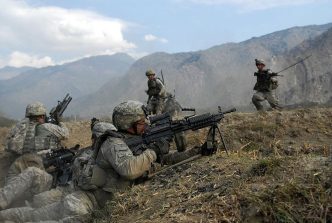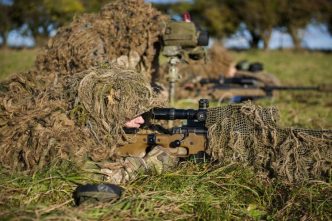The Fast Rope Insertion Extraction System (FRIES), commonly referred to as fast-roping or simply fast rope, is a method of descending a sturdy rope from a helicopter. It was developed to quickly deploy troops to areas where a helicopter landing is impossible. This technique enables soldiers to respond quickly to emergencies and act as a rapid response force. Additionally, it permits them to carry out stealthy missions, including boarding ships while at sea.
Fast Rope
Fast-roping, also known as helo-rappelling, is a method of descending from a helicopter without using a harness. It involves jumping from the helicopter onto a thick rope, sliding down it while wearing heavy gloves, and then letting go of the rope at the bottom to be ready for action. This technique is employed when the helicopter cannot land and requires speed, as troops can only carry essentials. Additionally, it is useful when the helicopter needs to depart from the landing zone quickly. However, it should be noted that fast-roping is significantly riskier, and soldiers cannot bring heavy equipment, such as full backpacks, with them.

United States Air Assault units typically use rappelling to enter a Landing Zone (LZ). The LZ may be uneven and unsuitable for helicopter landings. The LZ is either secured or located far away from the enemy to keep the helicopter safe from enemy fire. Troops wear a harness and rappel into the LZ, typically two or four at a time. They bring their equipment, including backpacks, but must release themselves from the harness after landing.
Air Assault
Air assault refers to using helicopters to insert troops into secure areas or behind enemy lines. It is also referred to as “Rappelling” or “Fast Roping.” VTOL, or Vertical Take-off and Landing, is another term used for this tactic. Air Assault is a more advanced evolution of airborne tactics and has become increasingly popular in modern warfare, especially in the War on Terror. The United States Army last conducted a combat parachute operation during the opening stages of Operation Iraqi Freedom, when the 173rd Airborne Brigade jumped into northern Iraq.

The tactical advantage of air assault operations, as opposed to fast-roping alone, includes speed, stealth, and deception. Ground Force Commanders prefer to land a UH-60 helicopter and disembark all troops within 5-10 seconds instead of having a Blackhawk hover for 30-60 seconds while 12 troops slide down the ropes. Landings are less risky than prolonged hovering.
Air Assault allows troops to disembark with full combat loads and move quickly. In contrast, troops’ equipment, including backpacks, are lowered separately during fast-roping, which exposes them to danger for a longer period while they retrieve their equipment.
Air Assault vs. Fast Rope
Air assault can be conducted using both fixed-wing aircraft and rotorcraft. However, fast-roping is a technique that can only be executed by rotorcraft. This has several implications:
- Fixed-wing aircraft can carry more troops and equipment, resulting in a larger and stronger force inserted in one pass.
- When fast-roping, the transport helicopter must hover until all troops have landed, leaving it in a highly vulnerable position.
- Parachute drops can be performed from a higher altitude and speed, protecting both the aircraft and troops.
- Due to the higher altitude and speed of parachute drops, it is much easier to perform a stealthy insertion compared to using helicopters, which are practically guaranteed to alert enemies in the vicinity.
That being said, there are also advantages to fast-roping. All troops land in a single location, usually the desired spot. With parachute drops, troops can be scattered over a large area, requiring regrouping and potentially putting them in a difficult situation. Some terrain also makes parachute drops very risky or impossible, and having rotorcraft in the area offers more flexibility in terms of mobility and deployment.
History
The technique of fast-roping was first developed by the British military in partnership with UK rope manufacturer Marlow Ropes and was first used in combat during the Falklands War. The original rope was made of thick nylon and was used similarly to a firepole. However, the ropes used today have been updated; they are braided, resulting in a textured outer circumference, which is easier to grip. In the past, each person would hold the rope for the next person, but this practice has been phased out.
Techniques
While it poses more risks, fast-roping is faster and more straightforward than traditional rappelling, especially when the person is carrying a heavy load as the rope is not attached to them with a descender. The user holds onto the rope with gloves and uses their hands and feet to slide down without additional safety measures.
Multiple individuals can slide down the same rope simultaneously, provided a gap of approximately 3 meters (9.8 ft) between them to allow enough time for each person to reach the ground safely. It is essential to use gloves to prevent friction burns during the descent.
Fast-roping is also used to board ships, taking around 30 seconds, when a quick and surprise takeover is needed.
Special Operations Forces
Fast-roping is a suitable technique when the landing zone is too irregular for a safe helicopter landing. As the rotor wash of a helicopter is 1.5 times the length of the blade, hovering close to a building can cause an uneven distribution of lift, which may have contributed to the control malfunction during Operation Neptune Spear (the raid to capture/kill Osama bin Laden).
Rappelling is better suited for troops who do not have the same level of expertise as Special Operations Forces (SOF), who typically use fast-roping.












